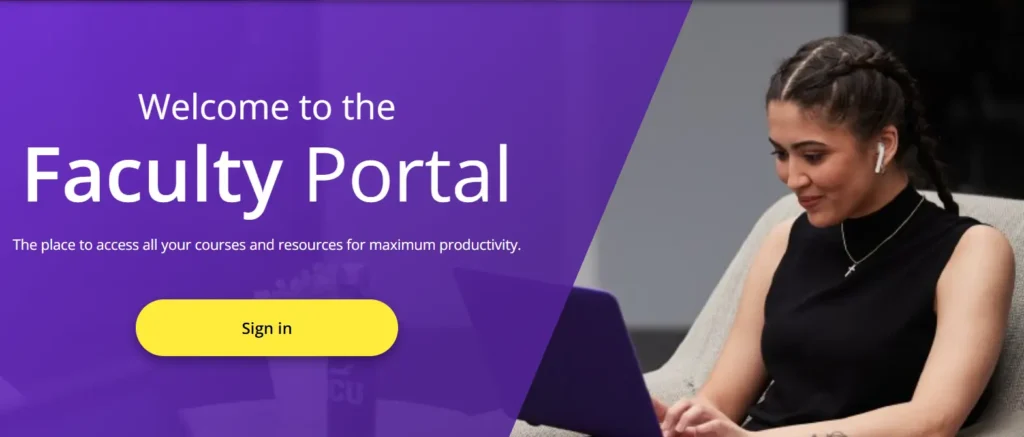GCU Faculty Portal – Login
The GCU Faculty Portal is your main hub for handling teaching duties and grabbing important university resources. Through this portal, you can check class rosters, submit grades, message students, and see campus announcements—all in one spot.
This easy access helps you keep things organized and efficient every semester. If you’re new to Grand Canyon University or just want to get more out of the portal, learning how to navigate it is a must. Also faculty helps to announce updates about GCU Scholarships and Applications for students.
Getting familiar with the tools makes daily tasks smoother. Plus, you won’t miss any critical updates.

Understanding the GCU Faculty Portal
The GCU Faculty Portal is an online platform that simplifies your academic responsibilities at Grand Canyon University. It brings together key tasks, offers support, and gives you secure access to courses, student info, and teaching resources.
Overview of the GCU Faculty Portal
GCU student portal is the main asset of students and faculty portal is teacher’s main entry point for managing course activities, communication, and reporting at GCU. Its design makes it easier for you, your students, and university services to connect quickly.
The layout is pretty standardized, so you can spot class rosters, grading tools, and big announcements in no time. Most tasks happen right inside the portal, so you rarely need to jump to other apps.
It works on both desktop and mobile, which is great for managing courses on the go. I’ve found that flexibility makes a real difference.
Core Features and Navigation
Here are some of the main features you’ll use:
- Gradebook: Enter, adjust, and check student grades instantly.
- Class Roster: See your student lists, their contact info, and attendance records.
- Course Materials: Upload and organize syllabi, lectures, and assignments.
- Messaging Center: Chat securely with students or other faculty.
Navigation’s simple—a sidebar and dashboard keep things tidy. Tabs for Courses, Grades, and Calendar are just a click or two away.
The interface focuses on readability and speed. I rarely have to wait long for updates or pages to load, which is honestly a relief.
Access Requirements and Login Procedures
You’ll need an active GCU faculty account to use the portal. Usually, GCU IT sends your credentials during onboarding.
To log in, head to the official GCU Faculty Portal website and enter your username and password. Sometimes, multi-factor authentication pops up for extra security.
If you forget your password, just use the “Forgot Password” function—it’ll walk you through recovery. For account lockouts or other issues, the university’s IT helpdesk can usually sort things out.
Support Resources for Faculty
Support is pretty solid for faculty portal users. GCU offers:
- Online Guides: Step-by-step tutorials and FAQs for common tasks.
- IT Helpdesk: Phone, email, and live chat for tech problems.
- Workshops: Training sessions for new and advanced features.
You’ll find the support section in the portal’s help menu. Documentation gets updated often, and IT responds quickly to big problems.
There are also peer support communities, so you can swap solutions and teaching tips with colleagues. That’s always a plus, in my opinion.
Key Functions and Academic Tools
The GCU Faculty Portal makes academic and admin tasks a lot easier. You can manage courses, grade assignments, check student records, and see updated info on tuition and fees—all in one place.
Course Scheduling and Management
With the portal, you can view your upcoming courses, assign sections, and manage your teaching schedule. The dashboard shows your course rosters, meeting times, and classroom locations.
Use the scheduling module to request changes, swap times, or let admin know about conflicts. You’ll get automatic notifications if your schedule or room changes.
All your course materials, syllabi, and documents can be uploaded or updated for students to access right away. The portal also supports group projects and built-in messaging for coordinating with students or fellow faculty.
This centralized setup cuts down on admin headaches and helps keep scheduling accurate.
Grade Submission and Monitoring
The gradebook tool lets you enter, adjust, and submit grades for each course. You can put them in one by one or upload a whole batch with a CSV file.
Automated reminders help you hit deadlines for midterm and final submissions. You can see grade changes and track student progress at a glance.
Audit logs keep a record of everything for compliance. If you need to change a grade, you can request it right in the portal for review.
Once you submit grades, students can see them immediately. You can also check that they received and confirmed their grades.
The system supports both percentage and letter-grade formats, following GCU’s policies.
Accessing Student Transcripts
You can review student academic history and official transcripts for advisees in the portal. Quick filters make it easy to find courses, GPA, or credits.
All transcript access is protected for privacy and FERPA compliance. When advising, you can check a student’s current standing and help them choose courses based on past performance.
You can start electronic transcript requests, and you get read-only access to keep records secure. If you spot a discrepancy, there are ways in the portal to flag it or talk to the registrar.
Faculty Resources for Tuition and Fee Information
The Faculty Portal lists current tuition rates, fee schedules, and payment deadlines. You’ll see breakdowns for undergrad, grad, and special program fees.
Reference tables and downloadable PDFs explain billing, refund schedules, and financial aid options. These resources can help you answer tuition fee questions during advising.
You’ll get notified of tuition changes through portal messages. If a student has a tricky payment question, the portal gives you finance office contacts so you can direct them or escalate the issue quickly.
Frequently Asked Questions
You can reset your password, find faculty directories, and get admissions help in dedicated sections of the GCU faculty portal. The portal also lets you log in to HALO, see your courses and rosters, and review your teaching performance.
